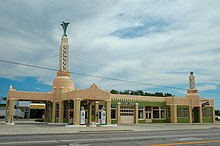


Americas
The US has fine examples of art-deco architecture. New York, Chicago, and Detroit have a great many deco buildings: the famous skyscrapers are the best known, but notable deco buildings can be found in various neighborhoods. Detroit's many examples of art-deco architecture include the Fisher and Guardian Buildings both of which are National Historic Landmarks. Los Angeles, California, is also rich in art-deco architecture, particularly along Wilshire Boulevard, a main thoroughfare that experienced a building boom in the 1920s. Notable examples include the Bullocks Wilshire and the Pellissier Building and Wiltern Theatre, built in 1929 and 1931 respectively. Both buildings underwent recent restoration.[34][35]
Miami Beach, Florida, has a large collection of art-deco buildings, with some thirty blocks of hotels and apartment houses dating from the 1920s to the 1940s. In 1979, the Miami Beach Architectural Historic District[36] was listed on the National Register of Historic Places. Nearly all the buildings have been meticulously restored and painted in their original pastel colors.[37]
Fair Park, located in Dallas, Texas, is large collection of Art Deco structures. Much of the Art Deco heritage of Tulsa, Oklahoma remains from that city's oil boom days.[38] Houston, Texas has some surviving buildings, such as the Houston City Hall, the JPMorgan Chase Building, Ezekiel W. Cullen Building, and the 1940 Air Terminal Museum, though many are threatened by modern development.[39] In Beaumont, the Jefferson County Courthouse, Kyle Building and the First National Bank Building are some of the few Art Deco buildings still standing in the city.
Hoover Dam is a somewhat unusual example of Art Deco design. Dam guides frequently state that the design was to be Gothic, right down to the installation of gargoyles with water shooting out of their mouths.[citation needed]
Kansas City is home to the Kansas City Power and Light Building which completed construction in 1931. This building serves as a great example of the Great Depression and its effect on Art Deco construction. Original plans called for a twin tower to be built next to it on its west side. However, it was never built due to financial constraints. As a result, the 476-foot (145 m) tower has a bare west side, with no windows. Other examples of Art Deco buildings in Kansas City include Municipal Auditorium (Kansas City), the Jackson County Courthouse (Kansas City, Missouri), Kansas City City Hall; and 909 Walnut.
Cincinnati, Ohio houses the Cincinnati Union Terminal, an Art Deco style passenger railroad station that opened in 1933. After the decline of railroad travel, most of the building was converted to other uses. It now serves as the Cincinnati Museum Center, which welcomes more than one million visitors per year and is the 17th most visited museum in the United States.[40][41] Cincinnati is also home to the Carew Tower, a 49-story Art Deco skyscraper built in 1931.
In 2005 the largest residential restoration project in the country and the largest collection of Art Deco buildings in New Jersey began at the 14-acre (57,000 m2) site of the former Jersey City Medical Center. The conversion of the national historic site to a residential enclave had as of 2009 been completed on three of the several buildings on the site.
One of the most famous surviving examples of the Art Deco style is the famous RMS Queen Mary, which is currently moored in retirement in Long Beach, California as a floating museum and hotel, a true lasting reminder to the past glory of the once numerous trans-Atlantic ocean liners, and to the Art Deco period.
Some of the finest surviving examples of Art Deco art and architecture are found in Cuba, especially in Havana. The Bacardi Building is noted for its particular style,[42] which echoes the classic themes of Art Deco. The style is expressed in the architecture of residences, businesses, hotels, and many pieces of decorative art, furniture, and utensils in public buildings, as well as in private homes.[13]
Another country with many examples of rich Art Deco architecture is Brazil, especially in Porto Alegre, Goiânia and cities like Cipó (Bahia), Iraí (Rio Grande do Sul) and Rio de Janeiro, especially in Copacabana. Also in the Brazilian Northeast – notably in countryside cities, such as Campina Grande in the state of Paraiba – there is a noticeable group of Art Deco buildings, which has been called “Sertanejo Art Deco” because of its peculiar architectural features.[43] The reason for the style being so widespread in Brazil is its coincidence with the fast growth and radical economic changes of the country during 1930-1940.
In Santiago, Chile, Hotel Carrera (no longer a hotel) is a very fine example of Art Deco architecture. Art deco buildings are also numerous in Montevideo, Uruguay, including the iconic Palacio Salvo, which was South America's tallest building when it was built in the late 1920s.
In Argentina, architect Alejandro Virasoro introducted Art Deco in 1926 and revolutioned the use of reinforced concrete, with the Banco El Hogar Argentino and the Casa del Teatro (both in Buenos Aires) between his most important works. Edificio Kavanagh (1934), by Sánchez, Lagos and de la Torre, was the tallest reinforced concrete structure at its time, and a notable case of late Art Deco. In the Buenos Aires Province, architect Francisco Salamone left a cemetery portals, city halls and slaughterhouses commissioned by provincial government during 1930s, designed in a very personal style which combined Art Deco with futurism. In Rosario, Santa Fe, the Palacio Minetti is the most representative Art Deco piece.

No comments:
Post a Comment